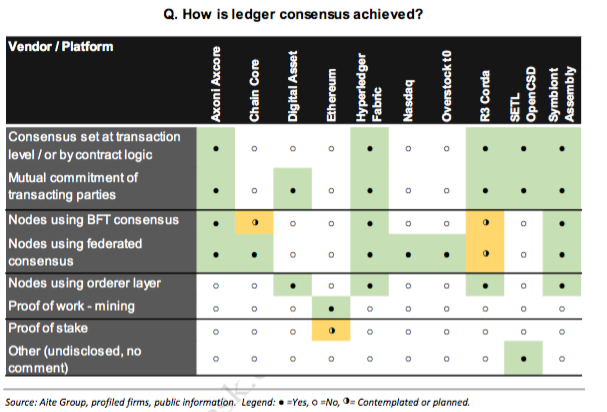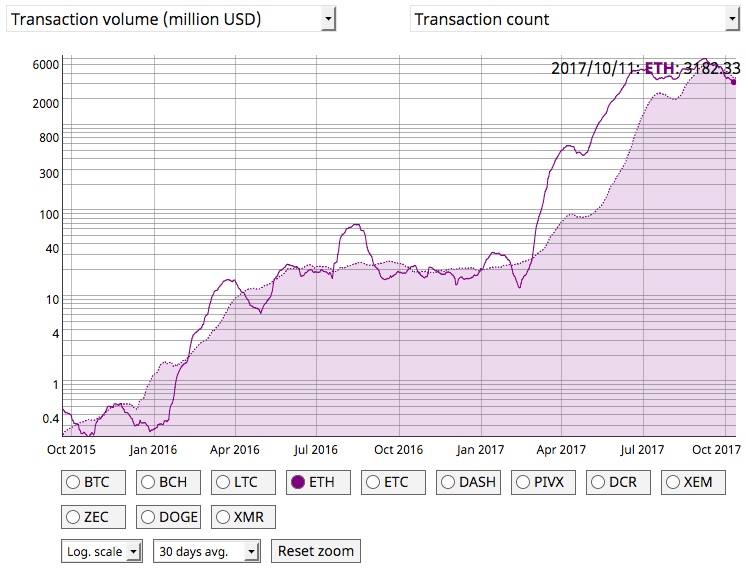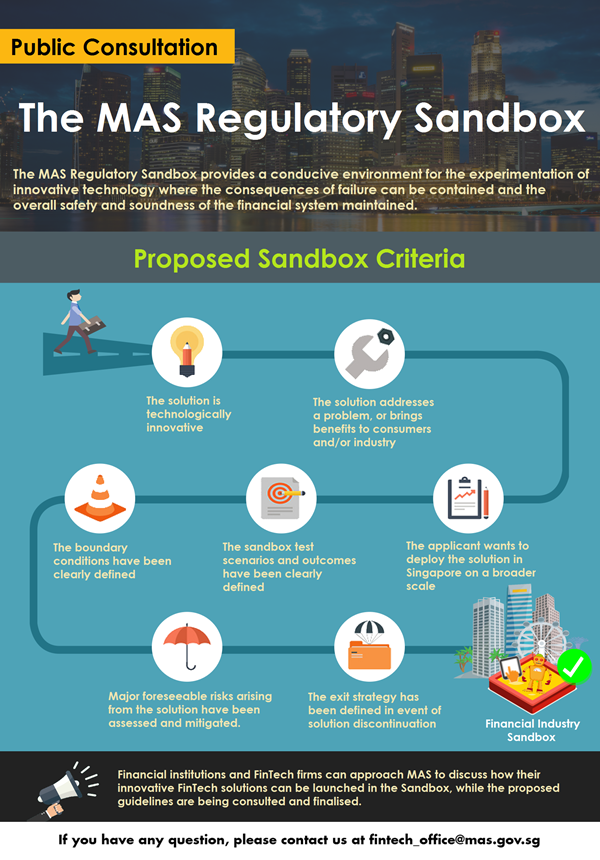Prior to Bitcoin, the process for maintaining the transaction ledger remained effectively unchanged since the Medici developed double entry accounting in the 14th century. The Medici process of accounting required banks…

Bitcoin is going to do to banks what email did the post office and Amazon did to retail. Understandably those at the center of the financial system are concerned.
The banker’s mantra of “blockchain not bitcoin” has caught fire on Wall Street – everybody loves blockchain, they may not know what it is, but they love it! Jamie Dimon, CEO of JPMorgan, hates Bitcoin, but loves blockchain, Goldman Sachs CEO, Lloyd Blankfein, has embraced blockchain while he is warming to Bitcoin. Admittedly, I suffered from the same love affair with blockchain. As an early adopter of Bitcoin I still had feelings for the currency, but for a period of time I was infatuated with blockchain.
The cryptocurrency and blockchain security pioneer Ledger has secured a $7M Series A funding led by MAIF Avenir, with the participation of Xange, Wicklow Capital, GDTRE, Libertus Capital, Digital Currency Group, The Whittemore Collection, Kima Ventures, BHB Network and Nicolas Pinto. This latest investment follows a $1.5M round in 2015 and brings the total funding to $8.5M, one of the biggest blockchain related start-up funding to date in Europe.
Ledger’s competitive edge is its technology: a low-footprint crypto-embedded operating system built for Secure Elements and Secure Enclaves which enables full orchestration of code and systems directly from the secure core. Ledger designs a line of products for the cryptocurrency and blockchain market: hardware wallets for consumers, server appliances for enterprise and embedded solutions for connected objects.
The company’s flagship products are the Ledger Nano S and the Ledger Blue, hardware wallets securing cryptocurrencies and digital identities.
Ethereum, Digital Asset, R3, and more go head-to-head in this detailed blockchain study by Aite Group.
Research and advisory firm Aite Group is preparing to release a detailed comparison of what it deems the ‚Top 10‘ distributed ledger platforms suited for securities settlement.
After eight months of research, including lengthy interviews with each of the platforms included, the report’s author Javier Paz has crafted a side-by-side analysis complete with defining characteristics, ranging from the project’s consensus mechanism to business model.
At the end of the 80-page report, Paz draws a series of conclusions for sectors including regulators and cloud providers.
But, Paz reserves his sternest conclusion for financial technology vendors not yet dealing in distributed ledger, or as he calls it, elsewhere in the report, ‚chaintech‘.
„Blockchain hype is high,“ he writes. „But the threat to traditional fintech vendors is real.“
Paz continues:
„This is the time for vendors to pivot and decide whether to acquire or develop relevant blockchain technology, years before a vendor’s client feel that a move to blockchain technology is required.“
Path to profit
Platforms selected based on their potential to more quickly and transparently conduct post-trade securities settlement include Axoni, Chain, Digital Asset, Ethereum, Hyperledger, Nasdaq, R3, Setl, Symbiont and tØ.
The report details how each of the firms earns money, or intends to earn money. Most plan to give away the building blocks of their services for free as part of various open-source licenses.
While giving enterprising companies the ability to build solutions from scratch, the startups will charge licensing fees to use the application layers they themselves have built.
Of the 10 firms, only Hyperledger and the Ethereum Foundation do not provide development teams to potential customers for a fee, instead relying on third-party consulting firms to help potential users build with the code.
But what is not mentioned is the price.
„Buyers and sellers discover the equilibrium price for that new thing after a good deal of haggling and window shopping,“ Paz writes. „Similarly, neither chaintech vendors nor their target audience has a perfectly clear sense of what should be the price tag for the new service.“

Tech dive
Another notable side-by-side comparison is the consensus mechanisms employed by each of the groups.
Of the numerous criteria, only Digital Assset, ethereum and Setl are not marked with the category „nodes using confederated consensus“.
„A growing trend, adopted by five chaintech platforms and spearheaded by R3,“ writes Paz, „calls for consensus taking place at the transaction level, requiring the consent of at least two counterparty nodes.“

In conversation with CoinDesk, Javier Paz admitted that, in part, the exercise of aggregating so much data was part of his own personal attempt to better understand the technology.
But other than for his own gratification, Paz says the report is aimed at C-suite executives, regulators and platform developers themselves, who he believes might become so focused on their own projects that they lose sight of the competition.
For the report, Paz sifted through oral interviews, written responses, and schematics provided by 30 senior executives from 16 blockchain firms, four financial market utilities and others in search of the comparison points.
He estimates that the methodology could cut down on a reader’s learning curve by between one month and three months.
The full report is due out later this month.
Disclosure: CoinDesk is a subsidiary of Digital Currency Group, which has an ownership stake in Chain and Axoni.
Measuring cups via Shutterstock
Quelle: ‚Top 10‘ Blockchains Report Concludes: Now is the Time to Pivot – CoinDesk
Blockchains are beginning to turn green. This post describes some of the IC3 research in this direction.
The glorious view from our windows at Cornell Tech takes in 432 Park Avenue, the tallest residential building in the world. This tower is a monument to many things. Above all, for a student of Financial systems, it epitomizes ways to store wealth with breathtaking waste. (Fittingly, it was inspired by a wastepaper basket, shown to the right.) Buildings like it are sprouting up around NYC as investment vehicles for the ultra-wealthy, and their owners don’t actually live much in them. 432 Park and its ilk are essentially hollow vaults.
Something similar can be said for Bitcoin. As a concept and technological inspiration, Bitcoin is a marvelous thing. And unquestionably like 432 Park, it does see legitimate and valuable uses (and some shady ones). As a currency, though, Bitcoin serves in no small degree as a wasteful and ecologically damaging way for people to park their money.
There are a number of ways to substantiate this claim. One is in terms of its electricity consumption. Estimates vary, but it is likely that the Bitcoin network consumes roughly as much electricity as a nuclear reactor, about 1/3 of the entire electricity consumption of the entire country of Ireland. (See our back-of-the-envelope calculations in the blog notes.) To view this in another light, a recent IC3 paper estimated the cost-per-confirmed transaction at as much as $6.20 in capital costs and electricity. (Transaction rates have been rising, and today the figure is substantially lower, but still high.) That’s $6.20 in resources per transaction to move money between accounts in the same system.
Bitcoin proponents argue that this is simply the cost of decentralization. A credit-card network doesn’t provide the pseudonymity, freedom from government interference, portability, and other features of Bitcoin, so it isn’t comparable. This is true. But it isn’t a law of nature that a system like Bitcoin should be so resource-intensive. Researchers at IC3 believe that the many benefits of Bitcoin can be had without the waste. In a few papers released over the past month or so, we’ve outlined three different approaches to the development of greener alternatives:
- PieceWork is a tweak to standard cryptocurrency PoWs that enables recycling of mining effort.
- Resource-Efficient Mining (REM) repurposes innately useful workloads for mining effort. It relies on use of a trusted hardware technology called Intel SGX.
- Snow White is the Proof-of-Stake system with rigorous security guarantees.
PieceWork: Recycling PoWs

If we can’t reduce waste at the source, why not recycle? That’s the premise of the first, and simplest idea, called PieceWork. Piecework involves a slight modification to the standard Proof-of-Work (PoW) construction, decomposing it into two layers. One layer produces small PoWs called puzzlets that play a critical role in the mining process and can also, as we shall show, serve useful non-mining purposes.
Consider a standard cryptocurrency, abstracting away into a single value X the details of what gets hashed into a PoW (transactions, the previous block, etc.). A miner’s task then is is simply to search for an input (“nonce”) n∈N for which
H(X, n) ≤ Z,
where Z is a threshold representing the difficulty of the PoW.
To decompose a PoW into two layers, we instead construct it as follows:
H(X, n) = Fout (X, Fin (X, n; rin ), rout ),
where rin = H0(r) and rout = H1(r) for distinct hash functions H0, H1 and a secret value r. (These two values are a technical requirement to prevent what are called block withholding attacks. See the blog notes.)
A valid solution is a value n such that
Fin (∙, n, ∙) < Zin and Fout (∙, n, ∙) < Zout.
To solve this puzzle or PoW, a miner must first find an n such that Fin (∙, n, ∙) < Zin. This inner-puzzle is what we call a puzzlet. To solve the whole PoW, a miner must find a puzzlet solution. The puzzlet solution must additionally satisfy Fout (… n…) < Zout, meaning that a miner must in general come up with many puzzlet solutions to solve the PoW as a whole. By setting Zin + Zout = Z, one obtains a PoW with the same difficulty as that in (1).
What’s the benefit of this two-layered structure? A puzzlet, i.e., the task of finding a solution n to Fin (∙, n ,∙) < Zin, can be outsourced by a miner or mining pool operator to a worker, and put to any of several non-cryptocurrency goals. DoS prevention for TLS is one example. TLS requires computationally intensive crypto operations from a server to set up connections. Thus it’s a natural target for DoS attacks, prompting the idea of requiring clients to solve PoWs if a server comes under attack, an idea now floated in an IETF proposal. These PoWs used for DoS mitigation can themselves be puzzlets. The effect is that the server becomes a mining pool operator, and its clients become workers. And a DoS attacker effectively showers the victim HTTPS server with cryptocurrency. (Of course, a server can also dispense puzzlets and make money even when it’s not under attack…) Other examples of puzzlet uses are spam prevention (the original PoW goal proposed by Dwork and Naor), MicroMint, and Tor relay payments.
In summary, PieceWork requires only a small modification to standard cryptocurrency PoWs. It turns them into dual-use computational problems and recycle wasted mining effort. How much recycling it can feasibly accomplish is an open research question. PieceWork benefits from a number of previous, related ideas. Our short paper on it can be found here. PieceWork will be presented in April at BITCOIN 2017.
Resource-Efficient Mining (REM): Using Innately Useful Work as Mining Effort

A very different approach to minimizing waste is embraced in our second project, a system called REM. Rather than relying on hash-based PoWs, it makes use of an entirely different type of PoW, in which the W, i.e., the work, is useful. We call this concept Proof of Useful Work (PoUW).
Of course, traditional PoWs have several useful properties, prime among them the ease with which solutions can be verified. Most workloads don’t have this property. To enable verification of work on arbitrary useful workloads, REM relies on a new technology: Intel SGX.
Intel’s new SGX (Software Guard eXtensions) trusted execution environment technology. In a nutshell, SGX enables the execution of an application in a hardware-protected environment, called an enclave, that is isolated from the operating system and other applications. It thus protects the application against tampering by even the owner of the machine on which it’s running. SGX also enables generation of an attestation that proves to a remote party that a particular application was running in an enclave. SGX is already supported in many recent-model Intel CPUs.
As a good way to see how SGX can facilitate mining, it’s worth discussing an elegant mining scheme proposed by Intel called PoET (Proof of Elapsed Time). The idea behind PoET is simple. If miners use SGX, then they can be forced to use only a sanctioned piece of mining software that simulates PoWs. Standard PoWs have solution times that are exponentially distributed. A PoET client can thus sample a solution time from an exponential distribution, simply sit idle until this time elapses, and then wake up with a block in hand. The first client to awake gets to publish its block. An SGX attestation proves to others in the system that the client idled as it should have.
PoET has several nice features. Foremost among them is the fact that (at first glance) it’s virtually energy-waste-free. Clients idle instead of hashing. Block solution times can be tuned to mimic those of a standard mining regime, like Bitcoin or Ethereum mining. Thus PoET can effectively be plugged into such schemes. It is also relatively egalitarian in that it achieves precisely one vote per CPU. PoET, though, has two technical challenges. We call these the broken chips and stale chips problems.
First, the broken chips problem. SGX security is imperfect and, as with any trusted hardware, it’s to be expected that a well-resourced adversary can break it. Thus, it’s to be expected that some SGX CPUs will be broken. In the basic PoET scheme, a broken chip has devastating effect, as it enables a miner to simulate a zero mining times and win every consensus round, i.e., publish all blocks. Intel has proposed a statistical testing regime to detect breaks, but details aren’t published and formal foundations are needed for a good analysis.
REM faces the same challenge. In REM, we have developed a rigorous statistical testing regime with formal foundations and shown analytically and empirically that it is highly effective: It can strictly limit the gains of adversaries that have broken chips while minimizing incorrect rejection of blocks from honest miners.
The stale chips problem is more subtle. Our economic analysis shows that in many practical settings in PoET and related systems, it will be advantageous for a miner to buy old (“stale”) SGX CPUs and cobble them together into “farms” that mine cheaply. Such farms reinstate a fraction of the waste that PoET is trying to avoid to begin with. This is where REM’s Proof of Useful Work (PoUW) approach comes into play. In a nutshell, with PoUW, miners run whatever workloads they consider to be useful—protein-folding computations and ML classification algorithms are a couple of examples considered in our work. Miners can prove that they did work on these problems using SGX. The probability of a miner mining a block is proportional to the amount of work she does. Thus, REM turns otherwise useful work into mining effort. Making PoUW work is technically challenging. It requires that workloads be themselves compiled and instrumented using SGX to prove correctness, an innovation of independent interest introduced in REM.
The biggest objection lodged against SGX-based mining is the fact that it places Intel in charge, undermining the decentralization at the heart of permissionless ledgers. Of course, Intel is already a trust anchor. But we’d view this another way, and characterize REM and PoET as partially decentralized. You can read about REM here, in a paper under submission.
Snow White: Proof of Stake with Rigorous Security Guarantees

Our final approach to reducing cryptocurrency waste is one both proposed and studied by many projects in the cryptocurrency community since the inception of Bitcoin. This idea is called proof of stake, and revolves around the basic premise that rather than mining simulating a lottery where your chance of finding a block is proportional to computing power, mining simulates a lottery where your chance of finding a block is proportional to the number of coins (or “stake”) you have in the system.
A key roadblock to the adoption and deployment of proof of stake systems involves questions around the security guarantees that they provide. This continues to be an ongoing source of controversy and debate in the community, with sources like the Bitcoin Wiki claiming that “Proof of Stake alone is considered to an unworkable consensus mechanism” and efforts like Ethereum’s Casper project studying questions of how to design a maximally useful and relevant proof of stake protocol for the next generation of cryptocurrencies.
Despite its potential shortfalls, we believe proof of stake represents a critical new development and direction in both the blockchain and distributed consensus fields. With this in mind, we set out to apply previous work by Rafael Pass (an IC3 member) and others, in which a model for analyzing and proving consistency, chain growth, and restrictions on adversarial chain impact for proof of work blockchains was developed.
To more accurately model the nature of blockchain distributed consensus, and the implication of network delays, we propose a new model for consensus called the sleepy model. This model more accurately mimics the operation and naturally captures the design of permissionless blockchains. In the sleepy model, a user (node or miner) can leave or join the protocol at will. This is modeled by (non-crashed) users in the protocol being given the ability to “sleep”, or go offline and rejoin the network at some unspecified later date with unmodified original state. The key question then becomes how can we design a useful consensus protocol in the sleepy model, when at least half of all online nodes (or stake) is honestly following the protocol?
The guarantees of consistency and availability are rigorously defined in this new model, more accurately capturing the guarantees users expect from blockchain protocols. The analogues of proof-of-work style guarantees like chain growth (availability) and chain quality (integrity) are also discussed. We believe this new class of consensus protocols in the “sleepy” model represents one of the fundamental contributions of blockchains to the distributed consensus space. Neither the asynchronous, partially synchronous, or synchronous models, in either a permissioned or permissionless setting, prove sufficient to model or reason about these new consensus protocols or the probabilistic and often economic guarantees they provide.
To that end, we are working on two protocols proven in the Sleepy model: Sleepy and Snow White.
Sleepy is a simple protocol intended to achieve the guarantees of chain quality, chain growth, and consistency/agreement with 51% of online nodes being honest. This protocol is intended for deployment in a permissioned context, and assumes stake assigned or instantiated by some trusted source. This makes Sleepy ideal for bankchains or other permissioned deployments, in which the set of stakeholders is known a priori but the blockchain guarantees of robust, auditable distributed consensus remain desirable. Every second, every member of the committee is eligible to “mine” a new block in the system, which involves a standard block mining solution with a public source of entropy as the nonce. Standard difficulty adjustments retarget the block interval to a desired target, as in Bitcoin and Ethereum today. The challenges of choosing an appropriate, ungameable mining function and source of entropy are tackled in the work, and proof is given that no committee member can manipulate the protocol to their advantage.
Snow White, on the other hand, is an extension of Sleepy intended to provide the same rigorous blockchain-derived guarantees in a permissionless setting, such as in the deployment of a public cryptocurrency. Obviously, this is substantially more difficult: choosing appropriate committee members for the block lottery, as well as ensuring that no coalition of these committee members (of bounded size) can game the protocol for more than a negligible advantage, are highly nontrivial. The resulting protocol is actually quite simple: each step, a committee mines as in Sleepy, with a shared source of entropy h0. With sufficiently many bits of entropy in h0 and an appropriately selected committee weighted on stake, it is possible to prove the desired result of chain quality, growth, and consistency in the Sleepy model. Choosing both the committee and h0 such that no adversary or non-majority coalition of adversaries gain substantial advantage by deviating from the protocol is the key to the construction and concrete parameters of the protocol, which are discussed further in our full publication.
Sleepy and Snow White represent the first rigorously justified and proven blockchain consensus protocols in both the permissioned and permissionless proof of stake space. It is our belief that the rigorous proofs of security are valuable as both theoretical efforts and to guide protocol development and deployment. Both the proof and concrete parameterization of these protocols are highly non obvious, and while heuristic protocols designed elsewhere in the community (with only informal justification) may operate in a similar manner to Sleepy, there is no guarantee that subtle network-level, timing, committee / stake poisoning, and other attacks are not present in these protocols. In our work, we assume an optimal adversary with ability to delay network messages up to some arbitrary time, a very strong notion of attacker that makes our protocols the most rigorous conceived in the space thusfar.
You can read about the papers in prepublication manuscripts we have uploaded for release on ePrint: Snow White, Sleepy. Further conference or journal publications with implementation details of these systems, full proofs, simulation results, and experimental comparisons to existing cryptocurrencies are currently in development. We hope to share more exciting news about these new protocols soon.
[It is worth noting that our willingness to assume that the majority of online coins are honestly following the protocol is an assumption that `has been challenged <https://blog.ethereum.org/2016/12/06/history-casper-chapter-1/>`_ by the Ethereum foundation. We do not necessarily agree with these criticisms or model; we believe that the ε-Nash equilibrium achievable in *Snow White is sufficient for the design of a robust, decentralized coin. Nonetheless, we believe developing and proving protocols secure in this context is valuable: both as the most natural model for private blockchain deployments, and to illuminate common pitfalls in proof of stake protocol design that may lead to attacks in naive protocols. We look forward to a full specification of Ethereum’s Casper, and to comparing both its assumptions and attack surface with that of Snow White.
Notes
Back-of-the-envelope Bitcoin electricity consumption calculation
There are many estimates of the electricity consumption of the Bitcoin network, but we don’t find them convincing. For example, this widely cited one derives an upper bound of 10 GW (in 2014!). As we’ll see from a simple calculation below, that would imply that miners were losing huge amounts of money. So here’s our crack at a crude estimate.
Using the technique in this paper, to obtain a lower bound on electricity consumption, let’s take the Antminer S9 to represent the state of the art in mining rigs. It consumes 0.098 W/GH. The current mining rate of the Bitcoin network is about 3,330,000 TH/s. Thus, were all miners using Antminer S9s, the electricity consumption of the network would be about 326 MW. (Of course, many miners are probably using less efficient rigs, so this is a loose lower bound.)
To obtain an upper bound on electricity consumption, assume that miners are rational, i.e., won’t mine if it causes them to lose money. At the current price of about $1000 / BTC, given a 12.5 BTC mining reward and block production rate of about 6 blocks per hour, the global mining reward per hour is about $72,500. A common, extremely cheap form of electricity used by miners is Chinese hydroelectric power; the very low end of the levelized cost of such electricity is $0.02 / kWh. Thus rational miners will consume no more than 3.625 GW of electricity. (Of course, this estimate disregards the capital costs of mining, and is therefore probably a quite loose upper bound.)
Taking the log-average of these two bounds yields an estimate of 1.075 GW, about the output of a single unit in a nuclear power station. Ireland’s average electricity consumption is about 3.25 GW (as derived from this 2013 figure).
Again, this is a crude estimate, but we believe it’s probably within a factor of 2 of the real one.
Why use rin and rout in PieceWork?
It is possible to outsource mining with the standard cryptocurrency PoW H(X,n) ≤ Z, simply by declaring a puzzlet to be the problem of finding an n such that H(X,n) ≤ Z_{easy}, for some Z_{easy} > Z. In other words, a worker can be asked to find a solution to a PoW easier than the target. But with some probability, a solution to H(X,n) ≤ Z_{easy} will also be a solution to H(X,n) ≤ Z, i.e., will solve the outsourcing miner’s PoW.
The problem with this approach is that a malicious worker can mount a block withholding attack. If it happens to find a solution to H(X,n) ≤ Z, it can simply not submit it. Or it can demand a bribe from the outsourcer. Use of rin and rout conceals from a worker whether or not a puzzlet solution is also a solution to the global PoW, preventing such attacks.
Quelle: The Greening of Blockchains
The United Arab Emirates is ramping up blockchain development in a bid to become, by 2020, a leading center for innovation and the first government in the world to execute all of its transactions on a blockchain.
The move seeks to cut an estimated 100 million paper transactions annually and reduce the 25 million hours of work required in handling paper documents in Dubai alone.
Sheikh Hamdan Bin Mohammed Bin Rashid Al Maktoum, Dubai Crown Prince, launched the Dubai Blockchain strategy in October, which aims at achieving a high degree of efficiency in government departments.
Another area of the strategy seeks to create thousands of new jobs by leveraging blockchain technology to allow Emiratis, expatriates and investors to set up companies more easily.
„The strategy will result in substantial economic saving that can be reinvested in value-added sectors and will contribute to saving millions of hours wasted in entering data and ensuring their veracity,“ said Mohammad Abdullah Al Gergawi, Vice Chairman of the Board of Trustees and Managing Director of Dubai Future Foundation.
„It will also create new economic fields and businesses as the volume of blockchain market is expected to hit US$300 million over the course of the next five years.”
The strategy is a joint project between the government’s Dubai Future Foundation and Dubai Smart City Office.
Earlier this year, the Dubai Future Foundation launched the Global Blockchain Council, a public-private initiative that demonstrated the UAE’s commitment to the technology.
Under the Global Blockchain Council umbrella, prominent financial institutions, technology firms and startups are collaborating on a number of pilot projects that promise to increase efficiency in processes, cut costs and create new business opportunities. Among these projects, a system called BitOasis aims at creating a blockchain platform „to secure [the] flexidesk contracts and registration process.“ Another project, called the Kraken Bitcoin Exchange, seeks to build a financial infrastructure for Islamic finance operations. Both pilot projects are being overseen by Dubai Multi Commodities Center Authority.
Dubai Future Accelerators Selects Two Blockchain Companies for Pilot Programs
In September, Dubai Future Foundation kicked off the inaugural Dubai Future Accelerators, a 12-week program that seeks to connect international technology startups with government entities to create prototypes and pilots for the city of Dubai.
More specifically, Dubai Future Accelerators paired 30 companies with seven of Dubai’s public services: Health, Energy, Knowledge, Municipality, Police, Transport and the investment portfolio, Dubai Holding.
The program, which ended earlier this week, selected 19 out of the 30 companies to move forward to the pilot and prototyping phase. These will receive a total of Dh120 million (US$32.6 million) in investment.
Of the participating companies, 14 have already relocated their headquarters to Dubai, highlighting the city’s growing attractiveness.
“The UAE has become the foremost global platform for turning the future into reality,” said His Excellency, Mohammed Al Gergawi, Minister of Cabinet Affairs and The Future, and Vice Chairman of the Dubai Future Accelerators. “It is the ideal destination to materialize innovative ideas into tangible projects that have a significant impact on the economy and society — projects that can create better lives for us and for future generations.”
Among the companies that made it to the next phase, Loyyal, a loyalty and rewards platform, signed a deal with Dubai Holding for a pilot deployment aimed at creating the „internet of loyalty points, promotions and rewards“ by using blockchain technology. Specifically, it will seek to provide an innovative and cost effective solution to enhance and connect different loyalty programs.
The pilot will focus on the Jumeirah Group and TECOM Group, Dubai Holding’s sister company, bringing together their respective loyalty schemes to enable network-effect opportunities.
„We established the Global Blockchain Council here in Dubai less than a year ago, and are already seeing impressive advancements in the uptake of this technology,“ commented Saif Al-Aleeli, CEO of the Dubai Future Foundation and Founding Member of the Global Blockchain Council. „We are pleased by Loyyal’s progress with Dubai Points, their partnerships with the private sector, and look forward to working even closer with them as they bring the blockchain future to reality.“
As part of the deal, Loyyal will be deploying its proprietary and patent-pending blockchain and smart contract infrastructure solution to re-map the way Dubai Holding’s businesses interact with consumers and each other.
Alongside Loyyal, other blockchain startups that were selected for program integration included BlockApps, an Ethereum compliant platform for the development, deployment and management of enterprise blockchain applications, and ConsenSys. The largest Ethereum blockchain software company in the world, ConsenSys, will develop a real estate database using blockchain technology for the pilot program.
The 19 pilot projects are expected to create 135 job opportunities in Dubai over the next three months, which is projected to increase exponentially when the projects achieve tangible results, and the companies expand their activities.
The second round of the Dubai Future Accelerator program will kick off in the beginning of Q1 2017 and will see five additional government and private entities joining in: the Department of Economic Development, Dubai Smart Office, the General Directorate of Residency and Foreigners Affairs, Etisalat and du, both telecom operators in the UAE.
Source: Bitcoinmagazine
France’s central bank quietly released new details about its work with blockchain last week.
The Banque de France said on Friday that it had tested the tech for hypothetical use in the management of SEPA Credit Identifiers, or identification markers used to establish the identity of creditors within the Single Euro Payments Area. The trial marks its first publicly acknowledged blockchain trial.
According to the central bank, one of the key participants in the trial was the Caisse des Dépôts et Consignations, a public-sector organization that acts as a kind of investor on behalf of the French government through a number of subsidiaries. Paris-based startup Labo Blockchain and several unnamed French banks also took part in the test.
Work began in July, the Banque de France said, culminating in October with the creation of prototype tools for creating and managing SEPA Credit Identifiers. The central bank outlined how weekly meetings were held with stakeholders as the project moved forward, going on to indicate that more detailed insights into the project would be released sometime next year.
Word of the trial comes months after the central bank called for more research into the subject, arguing at the time that any testing should focus on both the positive and negative impacts the technology could hold for the finance sector.
The Banque de France evoked this sentiment in its announcement, noting in a translated statement:
This experience allows all the participating banks to share their analyzes on [the] impacts and opportunities of this technology.
With the trial, the French central bank becomes the latest institution of its kind to test the technology.
In the past year, central banks in Japan, Sweden and Singapore, among others, have launched similar efforts, with the European Central Bank announcing a new research undertaking in partnership with the Bank of Japan on 6th December. Earlier this month, the US Federal Reserve released its first major research paper on blockchain.
Image via Shutterstock
Quelle: France’s Central Bank Details its First Blockchain Test – CoinDesk
The DAO heist and subsequent reversal of funds on the Ethereum blockchain demonstrate why developers and miners of public blockchains should have more accountability.
The recent hack of the DAO (short for Decentralized Autonomous Organization) and the subsequent reversal of funds on Ethereum’s blockchain should finally put an end to a decentralization charade. People are, in fact, governing public blockchains, and we need to be able to trust them.
From the beginning, the core developers (who write, evaluate and modify the software code) and the powerful miners (holders of significant chunks of computing power within the network) have been the governing bodies of these so-called decentralized systems. Yet the romance of decentralization — with the seductive idea that we don’t have to trust anyone because no human is doing anything — has allowed many to overlook this important truth. Weiterlesen
Das Europäische Parlament hat am Donnerstag mit 542 Ja-Stimmen, 51 Gegenstimmen und 11 Enthaltungen den Bericht zu virtuellen Währungen und Blockchain, der zugrundliegenden Technologie, angenommen.
Zunächst: keine großen Überraschungen, hervorzuheben ist m.E. dieser Punkt 4:
…dass eine verfrühte Regulierung in dieser sich noch im Wandel befindlichen Situation möglicherweise nicht angebracht ist, da sie der Öffentlichkeit in Bezug auf die Vorteile oder die Sicherheit virtueller Währungen ein falsches Bild vermitteln könnte
Schön, dass hier zunächst die Dynamik innerhalb der Blockchain-Welt unbeeinflusst bleiben soll und die Vorzüge der Crypto-Currencies per se zunächst klar erkannt werden. Eine spätere Regulierung vor allem unter Geldwäsche und Terrorismusfinanzierungs-Gesichtspunkten macht allerdings absolut Sinn.
Es ist ähnlich wie mit dem Internet vor 20 Jahren: Das ganze Potential virtueller Währungen und der zugrundeliegenden Technologie lässt sich heute höchstens erahnen. In diesem frühen Stadium setzen wir auf intensive Beobachtung und Überwachung der Entwicklungen statt zu frühe Detailregulierung. So können sich Innovationen entwickeln, während der Staat die Risiken im Blick behält
unterstreicht der SPD-Europaabgeordnete Jakob von WEIZSÄCKER, Berichterstatter im Parlament.
Quellen: Europäisches Parlament – Angenommene Texte – Donnerstag, 26. Mai 2016
Bundeswirtschaftsportal – „Bitcoin-Technik, Chancen nutzen, Aufsicht stärken“
The Monetary Authority of Singapore (MAS) today released a consultation paper on proposed guidelines for a “regulatory sandbox” that will enable financial institutions (FIs) as well as non-financial players to experiment with financial technology (FinTech) solutions…
Source: http://www.mas.gov.sg/News-and-Publications/Media-Releases/2016/MAS-Proposes-a-Regulatory-Sandbox-for-FinTech-Experiments.aspx





